Even the sleepiest town in Guatemala explodes with life on market day. Busloads of Mayans bring their wares and shopping bags to haggle, eat, and socialize.
Descending from the stuffed bus there is a parade of baskets leading to the heart of the market. The markets all begin calmly enough at the outskirts with ladies sitting on the ground alongside their pile of onions or blackberries, used clothes or weaving, laid out on a cloth. One more block and this disarray gains some structure. Wooden poles hold up canvas to block the sun for tables brimming with vegetables, huipiles, and cellphone accessories. On man sells handmade leather sandals, next to hand-me-downs from America. Plastic jugs from China compete with glazed pottery. Live chickens and turkeys hang by their feet waiting to be inspected and crammed into bags on their way to the dinner table. Selling at least eight varieties of mango, one woman slices a sample from her vast array to tempt a potential buyer, and we smell the ripeness. A moment later, the stench of dried fish invades our nostrils, even as our eyes adjust to the sunlight filtered through blue tarp tinting huge chunks of hanging meat and turning our stomachs.
Of course, we are not here to shop for chicken heads or calla lilies. We’re here to absorb the spectacle of this weekly ritual. The thousands of Mayan women that crowd the streets constantly catch our eye. With brightly colored, intricately woven shirts, scarves, headbands, belts, and skirts, which identify them to their village. Even without the added stress of haggling for a bag of plantains for dinner, we exhaustedly slump into our bus seats for the ride back.



Leave a Reply